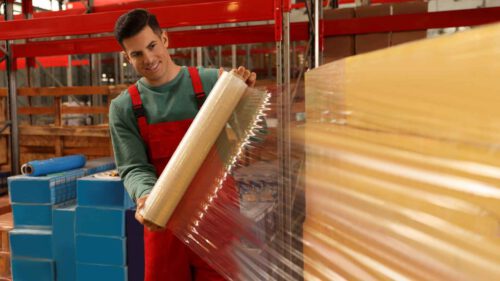
Stretch Film Strength
August 11, 2025
Water Bottle Caps: Types and Applications
October 4, 2025Stretch Film Elasticity
Stretch Film Elasticity: Key Factors, Testing Methods, and Karen’s High-Performance Results
Among the essential technical attributes of industrial stretch film, elasticity plays a critical role. In modern packaging systems—manual or automated—a stretch film must offer high elongation and the ability to maintain holding force after stretching. This ensures secure load retention, reduced material usage, and reliable performance across storage and transport conditions.
What Is Stretch Film Elasticity?
Elasticity refers to the film’s ability to stretch significantly without breaking and return (at least partially) to its original shape to apply holding force. In industrial use, films are often stretched to 150–300% of their original length. A lack of proper elasticity may lead to premature tearing or weak load containment.
What Affects the Elasticity of Stretch Film?
Polymer Formulation
Using high-quality LLDPE and metallocene blends significantly increases elasticity and strength.Production Method (Cast vs. Blown)
Cast stretch films offer more uniform elasticity and are ideal for automated machines.
Blown films are stronger but usually less stretchable and less consistent.
Multi-Layer Construction
Films with 3, 5, or 7 layers allow manufacturers to engineer layers specifically for elasticity, strength, or surface properties.Pre-Stretch Capacity
How much a film can stretch before application (pre-stretch) is a key performance factor. Higher pre-stretch capacity reduces film consumption and improves load stability.Film Thickness
Thinner films tend to stretch more easily, but only high-grade materials prevent early rupture under tension.
How Is Stretch Film Elasticity Measured?
1. Tensile Strength Test (ASTM D882)
A sample film is stretched using a tensile machine until it breaks. The percentage of elongation before breaking is recorded—this is the elasticity level.
2. Pre-Stretch Test on Wrapping Equipment
In real-world conditions, films are tested by stretching them using industrial wrappers to determine the maximum stretch rate without tearing.
Karen Stretch Film: Maximum Stretch, Minimal Risk
In recent technical evaluations, Karen’s stretch films demonstrated superior elasticity and durability under both lab testing and real-world application. With the ability to stretch up to 300% without tearing and maintain stable holding force, Karen’s films are ideal for high-demand industrial use.
📊 Karen’s Elasticity Test Highlights:
Pre-stretch up to 300% with no tearing
Excellent tension rebound for holding power
Reliable performance even in thin gauges
Works flawlessly on both manual and automated lines
🎯 Key Benefits of Karen Stretch Film Elasticity:
Reduces overall film consumption
Maintains load stability under transport stress
Prevents film breakage during wrapping
Uniform stretch behavior across the roll

Conclusion
Elasticity is a core performance indicator for stretch film in industrial packaging. Choosing a film with poor elasticity can result in excessive material usage, low load security, and frequent wrapping failures.
As one of Iran’s leading stretch film manufacturers, Karen delivers stretch films with engineered elasticity—providing consistent tension, durability, and performance trusted by packaging professionals.
In the following, you can watch the video demonstrating the elasticity performance of Karen’s stretch film.
